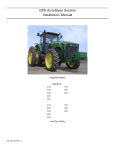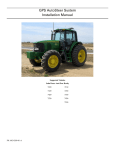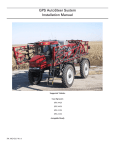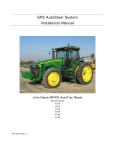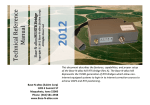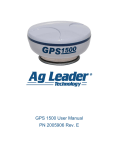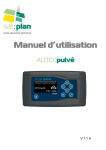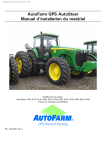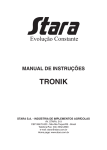Download 602-0237-01
Transcript
GPS AutoSteer System Installation Manual Supported Vehicles 9650 STS 9750 STS John Deere 9560 STS 9660 STS 9760 STS 9860 STS AutoTrac Ready PN: 602-0237-01-B 9670 STS 9770 STS 9870 STS LEGAL DISCLAIMER Note: Read and follow ALL Instructions in this manual carefully before installing or operating the AutoSteer system. Note: Take careful note of the information in the Safety Information section and throughout this manual. The manufacturer disclaims any liability for damage or injury that results from failure to follow the instructions and warnings set forth herein. Please take special note of the following warnings: 1. There is NO obstacle avoidance system included in the manufacturer’s product. Therefore, users must always have an operator on the equipment when the AutoSteer system is in use to look for any obstacles including people, animals, trees, ditches, buildings, etc. 2. During installation of the AutoSteer system and during the Calibration and Tuning processes the vehicle's wheels turn from side to side and the vehicle moves. Be sure that all people and obstacles are clear of the vehicle before installation, calibration and tuning, or use of the AutoSteer system. 3. Use of the AutoSteer system is NOT permitted while equipment is on roads or in public areas. Follow the instructions set forth below for ensuring that the system is OFF before driving on roads or in public areas. ii GPS AutoSteer System Special Requirements Tools This list consists of special tools required to complete the installation. The installer should have a complete set of common installation tools. 1/4” Allen Wrench 11/16” open wrench 8mm socket and ratchet 3/16” Allen Wrench 3/8” open wrench 10mm socket and ratchet 5/32” Allen Wrench 9/16” open wrench (2x) 13mm socket, ratchet and extension 1/8” Allen Wrench 1/2” open wrench 15mm socket and ratchet 4mm Allen Wrench 7/16” open wrench 16mm socket and ratchet 5mm Allen Wrench 1/2” socket and rachet 24mm socket and ratchet 3/16” open wrench 13mm open wrench Tape measure (12ft/3.6 m minimum) 7/8” open wrench 15mm open wrench Ten Foot Ladder (3 meter) #1 Phillips screwdriver 16mm open wrench Hacksaw with steel cutting blade #2 Phillips screwdriver 24mm open wrench Wire cutter small #2 Phillips Stubby Screwdriver Cleaning brush Cleaning rags Electrical Tape Hardware Installation Guide iii Safety Information Warning Alerts The AutoSteer system installer and manufacturer disclaim any responsibility for damage or physical harm caused by failure to adhere to the following safety requirements: • • As the operator of the vehicle, you are responsible for its safe operation. The GPS steering system is not designed to replace the vehicle’s operator. Tighten all screws, bolts, nuts and cable connections after the final assembly of the GPS steering system on the vehicle. WARNING To avoid electrical shock hazards, remove the roof module from the vehicle before driving under low structures or low electrical power lines. WARNING To prevent injury from falling, ensure you are in a stable position on the vehicle when installing or removing the roof rail and roof module. If the vehicle does not provide a safe platform, use a ladder to safely access the vehicle roof while installing or removing the roof rail and roof module. WARNING To prevent the vehicle from running over a person, you must never leave the vehicle while the GPS steering system is engaged. WARNING To understand the potential hazards associated with the operation of AutoSteer equipment read the provided documentation before installing the GPS steering system on a vehicle. iv GPS AutoSteer System WARNING To prevent the accidental engagement of GPS steering and loss of vehicle control while driving on roads, shut down the AutoSteer system (exit the program). Never drive on roads or in public areas with the GPS steering system turned on. Caution Alerts The AutoSteer system installer and manufacturer disclaim any responsibility for damage or physical harm caused by failure to adhere to the following safety requirements: CAUTION The roof module must be removed when transporting or driving the vehicle at speeds above 30 mph (50 km/h). The roof module can possibly detach due to wind loads at higher speeds. CAUTION The GPS steering system does not detect obstacles in the vehicle’s path. The operator must observe the path being driven in order to avoid obstacles. CAUTION When engaged, the GPS steering system controls only the steering of the vehicle. The operator must control the speed of the vehicle. Hardware Installation Guide v CAUTION The GPS steering system must be powered OFF when installing or removing the roof module. CAUTION The supplied roof module locking pin must be in place whenever the vehicle is in operation to prevent the roof module from releasing from its bracket. Vehicle Requirements The vehicle must be AutoTrac1 ready with the factory installed steering valve, Flow Meter sensor and steering wheel encoders. The vehicle steering system and hydraulic system must be in good working order before installing the AutoSteer system. Check for loose or worn parts. Drive the vehicle before installing the AutoSteer system and confirm that it steers straight and the wheels can be turned from lock to lock. Check the steering system hydraulic hoses and connections to ensure there are no oil leaks. The vehicle electrical system and battery must be in good working order. We recommend that the vehicle be fully cleaned with a high pressure washer before installing the AutoSteer system. A clean vehicle will facilitate the overall installation and cable routing. 1. AutoTrac is a trademark of John Deere, Inc. vi GPS AutoSteer System Important Information Note: Tighten all screws, bolts, nuts and cable connections after the final assembly of the Steering System on the vehicle. Technical Support Refer to your owner's manual for technical support information. Contact Information Refer to your owner's manual for contact information. Copyright © 2009 All Rights Reserved. Hardware Installation Guide vii viii GPS AutoSteer System Table of Contents Chapter 1 Installation Overview ....................................................................................................... 1 Kit Overview . . . . . . . . . . . . . . . . . . . . . . . . . . . . . . . . . . . . . . . . . . . . . . . . . . . . . . . . . . . . . . . 2 Assemblies . . . . . . . . . . . . . . . . . . . . . . . . . . . . . . . . . . . . . . . . . . . . . . . . . . . . . . . . . . . . . . . 2 Installation Procedure Outline . . . . . . . . . . . . . . . . . . . . . . . . . . . . . . . . . . . . . . . . . . . . . . . . . 6 Cable Diagram . . . . . . . . . . . . . . . . . . . . . . . . . . . . . . . . . . . . . . . . . . . . . . . . . . . . . . . . . . . . . 7 Chapter 2 Wheel Angle Sensor (WAS) Installation......................................................................... 9 Wheel Angle Sensor Installation Procedure . . . . . . . . . . . . . . . . . . . . . . . . . . . . . . . . . . . . . . . 9 Mounting Wheel Angle Sensor Hardware. . . . . . . . . . . . . . . . . . . . . . . . . . . . . . . . . . . . . . 10 Cutting Linkage Rods to Length . . . . . . . . . . . . . . . . . . . . . . . . . . . . . . . . . . . . . . . . . . . . . 13 Assembling Linkage Rod Hardware . . . . . . . . . . . . . . . . . . . . . . . . . . . . . . . . . . . . . . . . . . 15 Attaching and Adjusting Wheel Angle Sensor Linkage Rods. . . . . . . . . . . . . . . . . . . . . . . 17 Chapter 3 SA Module Installation .................................................................................................. 27 Chapter 4 Roof Module Installation................................................................................................ 31 Safety Notes . . . . . . . . . . . . . . . . . . . . . . . . . . . . . . . . . . . . . . . . . . . . . . . . . . . . . . . . . . . . . . . 31 Quick Release Rail Installation . . . . . . . . . . . . . . . . . . . . . . . . . . . . . . . . . . . . . . . . . . . . . . . . 32 Chapter 5 Display Installation ......................................................................................................... 37 Introduction . . . . . . . . . . . . . . . . . . . . . . . . . . . . . . . . . . . . . . . . . . . . . . . . . . . . . . . . . . . . . . . 37 Installation Procedure . . . . . . . . . . . . . . . . . . . . . . . . . . . . . . . . . . . . . . . . . . . . . . . . . . . . . . . 37 Chapter 6 Connecting System Cables............................................................................................ 41 SA Module Harness . . . . . . . . . . . . . . . . . . . . . . . . . . . . . . . . . . . . . . . . . . . . . . . . . . . . . . . . . 41 SA Module Connection . . . . . . . . . . . . . . . . . . . . . . . . . . . . . . . . . . . . . . . . . . . . . . . . . . . . 42 Wheel Angle Sensor Connection. . . . . . . . . . . . . . . . . . . . . . . . . . . . . . . . . . . . . . . . . . . . . 44 Steering Wheel Sensor Connection . . . . . . . . . . . . . . . . . . . . . . . . . . . . . . . . . . . . . . . . . . . 49 Electrohydraulic Steering Valve Connection . . . . . . . . . . . . . . . . . . . . . . . . . . . . . . . . . . . 53 Main Cable Harness . . . . . . . . . . . . . . . . . . . . . . . . . . . . . . . . . . . . . . . . . . . . . . . . . . . . . . . . . 54 Roof Module . . . . . . . . . . . . . . . . . . . . . . . . . . . . . . . . . . . . . . . . . . . . . . . . . . . . . . . . . . . . 55 Display . . . . . . . . . . . . . . . . . . . . . . . . . . . . . . . . . . . . . . . . . . . . . . . . . . . . . . . . . . . . . . . . . 61 SAM Harness. . . . . . . . . . . . . . . . . . . . . . . . . . . . . . . . . . . . . . . . . . . . . . . . . . . . . . . . . . . . 61 Cab Power . . . . . . . . . . . . . . . . . . . . . . . . . . . . . . . . . . . . . . . . . . . . . . . . . . . . . . . . . . . . . . 62 Chapter 7 Final Hardware Installation Checklist ........................................................................... 65 Chapter 8 Calibration and Tuning Notes ....................................................................................... 67 Vehicle Specific Installation Calibration and Tuning Guidelines . . . . . . . . . . . . . . . . . . . . . . 67 Hardware Installation Guide ix x GPS AutoSteer System 1 Installation Overview This Installation Overview chapter contains part numbers, kit overview diagram, cabling diagram and the installation procedure for the Installation Kit. • • • Kit Overview • Assemblies • AutoSteer Installation Kit Components • Bracket Kit Components • Termination Kit Installation Procedure Outline Cable Diagram This installation guide describes the installation of the AutoSteer system on several models of John Deere STS AT Ready combines. The AutoSteer installation kit PN: 188-0032-01 is used on these series of combines. The vehicle specific sub-assemblies for the these combine series are listed in Table 1-1. Table 1-1 Sub Assembly Part Numbers John Deere 9000 Series STS AutoTrac Ready Combines 153-0002-01 152-0028-01 Hardware Installation Guide 1 Kit Overview Kit Overview Note: The vehicles supported in this manual share the same top-level Installation Kit PN: 188-0032-01 that include these sub-assemblies. Figure 1-1 Installation Kit (PN: 188-0032-01) Table 1-2 Installation Kit Components (PN: 188-0032-01) Item Component Part Number 1. Bracket Kit 152-0028-01 2. AutoSteer Installation Kit 153-0002-01 Assemblies The vehicle installation kit contains the following components: • • 2 AutoSteer Installation Kit Components Bracket Kit Components GPS AutoSteer System Kit Overview AutoSteer Installation Kit Components Figure 1-2 AutoSteer Installation Kit Sub-Assembly (PN: 153-0002-01) Table 1-3 AutoSteer Installation Kit Sub-Assembly Components (PN: 153-0002-01) Item Component Part Number 1. SA Module Assembly 200-0206-01 2. SAM Harness 201-0240-02 3. Common Installation Kit 200-0497-02 4. SA Module Bracket 200-0190-01 5. Mounting Hardware 200-0076-01 6. RAM Base Kit 200-0508-01 10. Warning Labels 603-0074-01 Hardware Installation Guide 3 Kit Overview Bracket Kit Components Figure 1-3 Bracket Kit Components (PN: 152-0028-01) Table 1-4 Bracket Kit Components (PN: 152-0028-01) 4 Item Component Part Number 1. Roof Bracket Kit 200-0156-01 2. Installation Manual 602-0237-01 3. Display Bracket Kit 200-0137-03 4. Cable Routing Hardware 200-0174-01 8. Termination Kit 200-0481-01 9. Power Adapter Cable 201-0368-01 GPS AutoSteer System Kit Overview Termination Kit Figure 1-4 Termination Kit Components (PN: 200-0481-01) Table 1-5 Terminator Kit Components (PN: 200-0481-01) Item Component Part Number 1. Steering Encoder Terminator (High) 201-0241-01 2. Steering Encoder Terminator (Low) 201-0242-01 3. Flow Meter Spacer Screws 515-0013-01 4. Flow Meter Spacers 500-0214-01 5. Cables Ties 510-0015-01 Hardware Installation Guide 5 Kit Overview Installation Procedure Outline Note: The system interconnect cable diagram in the Cable Diagram on page 7 section of this chapter shows the AutoSteer electrical connections. 1. Verify shipped components. 2. Install the SA Module. 3. Install the roof rail on the cab roof. 4. Install the Roof Module on the roof rail. 5. Install the SA Module harness and route cables to the various sensors. 6. Route SA module data and power cable towards the cab. 7. Install the display bracket and the RAM mount ball inside the cab. 8. Install the display using a RAM mount arm. 9. Install the main data harness and route cables to roof module and power connector. Note: Instructions for connecting the vehicle kit cables to the display can be found in the display owner's manual. 10. Connect the main harness to the display harness. 11. Connect the main harness to the SA Module harness (12 pin + 2 pin connectors). 12. Verify all connectors are properly coupled and secured. 13. Power ON the AutoSteer system. 14. Calibrate the vehicle. 15. Tune the vehicle. 16. Verify the system has been installed properly and operates satisfactorily. 6 GPS AutoSteer System Kit Overview Cable Diagram Hardware Installation Guide 7 Kit Overview 8 GPS AutoSteer System 2 Wheel Angle Sensor (WAS) Installation This Wheel Angle Sensor Installation chapter information is provided in the following sections: • Wheel Angle Sensor Installation Procedure • Mounting Wheel Angle Sensor Hardware • Cutting Linkage Rods to Length • Assembling Linkage Rod Hardware • Attaching and Adjusting Wheel Angle Sensor Linkage Rods Note: The Wheel Angle Sensor is optional equipment and is not provided with the installation kit. The Wheel Angle Sensor installation instructions are provided for special installations, when required. Wheel Angle Sensor Installation Procedure Figure 2-1 shows the 9000 STS AT Ready combine wheel angle sensor assembly fully assembled. Figure 2-1 Wheel Angle Sensor Components Shield Wheel Angle Sensor Tie Rod Bracket Linkage Rods Cylinder Bracket Hardware Installation Guide 9 Wheel Angle Sensor Installation Procedure Mounting Wheel Angle Sensor Hardware 1. Find the Wheel Angle Sensor bracket mounting location. Note: The bracket should be located on the vehicle’s rear axle left side. See Figure 2-2. Figure 2-2 Wheel Angle Sensor Bracket Location Mounting Location 10 GPS AutoSteer System Wheel Angle Sensor Installation Procedure 2. Mount the Wheel Angle Sensor bracket. Secure with a bolt provided in your kit. See Figure 2-3. Figure 2-3 Wheel Angle Sensor Bracket Mounted Wheel Angle Sensor Bracket Mounted 3. Install the wheel angle sensor on the bracket as shown in Figure 2-4. Figure 2-4 Wheel Angle Sensor Mounted (shown with linkage rods attached) Wheel Angle Sensor Mounted Hardware Installation Guide 11 Wheel Angle Sensor Installation Procedure 4. Install the linkage rod “L” bracket on the tie rod using a muffler clamp. See Figure 2-5. Figure 2-5 Linkage Rod “L” Bracket “L” Bracket Muffler Clamp 12 GPS AutoSteer System Wheel Angle Sensor Installation Procedure Note: The threaded linkage rods must be cut to the correct lengths before final assembly. The linkage rods are shown assembled in Figure 2-6. See Table 2-1 and Table 2-2 for the cut and assembled linkage rod lengths. Figure 2-6 Wheel Angle Sensor Assembly Completely Assembled Linkage Rods Cutting Linkage Rods to Length 1. Measure and mark the two rods for cutting, according to the length shown in Table 2-1. Table 2-1 Linkage Rod Cut Lengths Item Length Rod A 5.7 inches (145 mm)a Rod B 11.4 inches (290 mm)a a. This measurement is the rod length prior to assembly with the ball joints. Note: Before cutting the linkage rods, verify the wheel angle sensor brackets will attach to the vehicle as shown in this manual and they are attached the correct distance from any reference points shown. If this is not possible, do not cut the rods until it is determined if these lengths work for your installation. Due to possible variations in the mounting positions, these measurements could be different. These measurements are provided as a reference only. The installer is responsible for ensuring the rods are cut to the proper length. Hardware Installation Guide 13 Wheel Angle Sensor Installation Procedure Note: Figure 2-7 shows the measurement points used to properly cut the linkage rods. Figure 2-7 14 Linkage Rod Cut Length Measurement Points GPS AutoSteer System Wheel Angle Sensor Installation Procedure 2. Use a hack saw to cut the linkage rod to length while it is held in a bench vise. See Figure 2-8. Figure 2-8 Linkage Rod Cutting Assembling Linkage Rod Hardware Note: The “after-assembly” center-to-center lengths of each linkage rod are shown in Table 2-2. Figure 2-9 shows the measurement points for the assembled linkage rods. Table 2-2 Assembled Linkage Rod Length Item Length Rod A 6.7 inches (170 mm)a Rod B 13.4 inches (340 mm)a a. This measurement is the rod length after assembly with the ball joints. Hardware Installation Guide 15 Wheel Angle Sensor Installation Procedure Figure 2-9 Linkage Rod (Assembled) Measurement Points Rod A Measurement Rod B Measurement Note: The threaded rods must be cut to the correct lengths before final assembly. 1. Attach a jam nut to the end of Rod A. See Figure 2-10. 2. Connect the eye connector to the end of the wheel angle sensor rod. As shown in Figure 2-10. Figure 2-10 Rod A Assembled Eye Connector Jam Nut 16 GPS AutoSteer System Wheel Angle Sensor Installation Procedure 3. Attach the jam nuts to each end of the linkage Rod B 4. Attach the ball joints to both ends of the linkage arm as shown in Figure 2-11. Note: The bolts for the ball joints should be facing the opposite direction as shown in Figure 2-11 for this installation. Figure 2-11 Linkage Rod Assembled Jam Nuts Ball Joints Attaching and Adjusting Wheel Angle Sensor Linkage Rods 1. Install the short linkage arm on the wheel angle sensor shaft. 2. Ensure a flat washer is placed under the screw head when attaching the linkage rod to the sensor shaft. See Figure 2-12. Figure 2-12 Washer on Shaft Screw Flat Washer Screw Head Nut Note: The washer should be on the bolt head side and not the nut side of the assembly. Hardware Installation Guide 17 Wheel Angle Sensor Installation Procedure 3. Do not turn the rear wheels or drive the combine before the wheel angle sensor has been adjusted using the AutoFarm Calibration screens. The potentiometer can only rotate a maximum of 180 degrees and if it is rotated beyond its mechanical stops, it will be permanently damaged. 4. Install the long threaded linkage on the tie rod bracket using a ball joint. 5. With the linkage rods disconnected, turn the steering wheel so that the wheels are centered (the vehicle will travel straight ahead when moving). 6. Temporarily attach the linkage rods. Note: Never attach the linkage rods to wheel angle sensor rod and turn the steering wheels manual or automatically until the fit has been verified. The linkage rods must remain apart while the steering wheels are turned to the maximum right and left positions and then temporarily attached at these positions. Failure to do this may cause the wheel angle sensor or vehicle to become damaged. Note: After the linkage rods are assembled in the following steps, they should move freely without touching any other parts and without overextending. Make any necessary adjustments to the linkage rods if there is an interference problem. WARNING Always shut down the vehicle when working around the steering axle and checking and adjusting the wheel angle sensor rod lengths. The steering axle could move suddenly and cause severe injury or death. 18 GPS AutoSteer System Wheel Angle Sensor Installation Procedure 7. Rotate the wheel angle sensor potentiometer on top of the mounting block so that the wire connector is parallel to the wheel angle sensor rod. Figure 2-13 Adjusting Potentiometer Angle Wheel Angle Sensor Connector Hardware Installation Guide 19 Wheel Angle Sensor Installation Procedure 8. Tighten the two screws that secure the potentiometer on the wheel angle sensor, after final adjustments. Use a 5/32” hex key and a 3/8” wrench. See Figure 2-14. Figure 2-14 Wheel Angle Sensor Potentiometer (shown on bench) 9. Disconnect the linkage rods and turn the steering wheel manually to the full left position. 10. Reattach the linkage assembly and verify that the sensor will not be damaged. See Figure 2-15. 20 GPS AutoSteer System Wheel Angle Sensor Installation Procedure 11. Adjust the rod lengths as necessary. Figure 2-15 Wheels Turned Full Left 12. Disconnect the linkage rods and turn the steering wheel manually to the full right position. See Figure 2-16. 13. Reattach the linkage assembly and verify that the sensor will not be damaged. 14. Adjust the rod lengths as necessary. Figure 2-16 Wheels Turned Full Right Hardware Installation Guide 21 Wheel Angle Sensor Installation Procedure 15. Repeat Step 5. through Step 14. until the rod lengths have been adjusted and the potentiometer is centered to obtain the maximum sensor movement. Note: The maximum movement is reached when the wheel angle sensor rod sweeps from approximately 3/16 inch (5mm) from both bolt heads holding the potentiometer on to the block when the wheels are turned to the maximum right and left positions. See Figure 2-17. Figure 2-17 Maximum Sensor Movement (as seen from bottom) Potentiometer Screw Stops Full Right Range of Movement Full Left Note: An Ohm meter can also be used to determine if there is enough sensor movement. Connect the Ohm meter to pins A and B of the wheel angle sensor. Measure the Ohm reading at the maximum left and right position. After subtracting the smaller number from the larger number, there should be at least a 3.75 Kohms change. The reading should also never go below 1.6 or higher than 6.6 Kohms as this is reaching the limits of the potentiometer and could damage the sensor. 22 GPS AutoSteer System Wheel Angle Sensor Installation Procedure 16. Tighten all jam nuts on the threaded rods. 17. Tighten the bolt securing the two linkage rods together. See Figure 2-18. Figure 2-18 Linkage Rod Ball Joint Bolt (different vehicle shown) 18. Tighten the screw on the sensor shaft. Use a 1/8” hex key and a 3/8” wrench. See Figure 2-19. Note: The rod should aim towards the vehicle front. Hardware Installation Guide 23 Wheel Angle Sensor Installation Procedure Figure 2-19 Wheel Angle Sensor Shaft Tightening 19. Secure the cable along the bracket top using cable ties, after the SAM harness is installed. Note: The AutoSteer system must be fully functional before you can perform Step 20. 20. Adjust the arm length until you get approximately 48000 counts from the wheel angle sensor. Note: If necessary, shorten Rod A to increase the wheel angle sensor counts. 24 GPS AutoSteer System Wheel Angle Sensor Installation Procedure 21. Tighten all jam nuts and fasteners. 22. Figure 2-20 shows the completed Wheel Angle Sensor installation. Figure 2-20 Wheel Angle Sensor Installation Complete Hardware Installation Guide 25 Wheel Angle Sensor Installation Procedure 26 GPS AutoSteer System 3 SA Module Installation This SA Module Installation chapter contains information for mounting the SA Module bracket and installing the SA Module. Note: The following instructions provide possible SA Module mounting instructions. However due to the variety of options available on vehicles and the possible configuration differences, it may be necessary to install the SA Module in an alternative location. If an alternative location is required, choose a location where the SA Module can be protected from damage from moving parts or crop debris and excessive moisture from weather and cleaning equipment. 1. Mount the SA module bracket on the vehicle frame side. See Figure 3-1. Figure 3-1 SA Module Location Mounting Location Hardware Installation Guide 27 SA Module Installation 2. Identify the holes on the grain tank support. See Figure 3-2. Figure 3-2 Mounting Holes Bracket Mounting Holes 3. Attach the SA Module bracket as shown using the M8 x 20 bolts, nuts and washers as shown in Figure 3-3. 4. Tighten with a 13mm socket and a 13mm wrench. See Figure 3-3. Figure 3-3 SA Module Bracket Mounted Mounting Bolts Phillips Mounting Screws (leave loose) 5. Slide the SA Module into place. 28 GPS AutoSteer System SA Module Installation 6. Mount into place by installing the other two screws. See Figure 3-4. Note: Leave the phillip screws loose until after you have routed the SA Module harness and have connected it to the SA Module. Figure 3-4 SA Module Mounted on the Bracket (shown with SA Module Harness attached) Mounting Screws SA Module Harness Note: Figure 3-5 and Figure 3-6 show the correct and incorrect SA Module installation orientation. Hardware Installation Guide 29 SA Module Installation 30 Figure 3-5 Correct SA Module Orientation Figure 3-6 Incorrect SA Module Orientation GPS AutoSteer System 4 Roof Module Installation This Roof Module Installation chapter contains information in the following sections: • • Safety Notes Quick Release Rail Installation Safety Notes • • • • The AutoSteer system must be powered OFF when installing or removing the Roof Module. The Roof Module must always be firmly secured to the roof rail using the hardware whenever the vehicle is in operation to prevent the roof module from releasing from its bracket and falling. The Roof Module must be removed when transporting the vehicle at speeds above 30 mph. Ensure you are in a safe position when attempting to access the cab roof. If necessary for safety, use a ladder to access the roof. Ensure you do not fall or drop the Roof Module. WARNING To prevent injury from falling, ensure you are in a stable position on the vehicle when installing or removing the roof rail and roof module. If the vehicle does not provide a safe platform, use a ladder to safely access the vehicle roof while installing or removing the roof rail and roof module. Hardware Installation Guide 31 Quick Release Rail Installation Quick Release Rail Installation 1. Access the cab roof. 2. Locate the two bolts shown in Figure 4-1 on each cab roof side. See Figure 4-1. 3. Remove the two bolts on each side. See Figure 4-1. Figure 4-1 Mounting Bolt Locations Mounting Bolt Locations 4. Align the mounting brackets to mounting holes and fasten the mounting brackets to the roof using the longer bolts and spare washers provided in the installation kit. See Figure 4-2. Note: The bolt attaching the roof bracket to the cab roof screws into a lowered channel on the roof surface. Place enough fender washers on the bolt hole under the bracket to make the top fender washer flush with the bottom of the bracket when the bracket is placed on the roof. These washers keep the roof from being bent as the bracket bolt is tightened. 32 GPS AutoSteer System Quick Release Rail Installation Figure 4-2 Roof Module Mounting Brackets 5. Tighten the bolts using a 24mm socket and ratchet. See Figure 4-3. Figure 4-3 Tightening Roof Module Bracket Bolts 6. Place the quick attach rail on top of the washers and center it over the cab. 7. Attach the roof module rail to the mounting brackets bracket using bolts, nuts and washers supplied. See Figure 4-4. 8. Tighten the bolts securely with a 24mm socket and ratchet. See Figure 4-4. Hardware Installation Guide 33 Quick Release Rail Installation Figure 4-4 Mount Rail on Brackets Mounting Bolt 9. The roof module rail is now installed on the brackets. See Figure 4-5. Figure 4-5 34 Quick Release Rail Mounted on Brackets GPS AutoSteer System Quick Release Rail Installation 10. Attach the three antennas to the proper roof module antenna connections. See Figure 4-6. Note: Hand tighten the connections. Do not over tighten. Figure 4-6 Attach the Antennas 11. Place the roof module on the quick attach rail. See Figure 4-7. Figure 4-7 Mounting Roof Module on Rail Hardware Installation Guide 35 Quick Release Rail Installation 12. Insert the locking pin into the quick attach rail. See Figure 4-8. Note: Press the button on the end of the pin handle to enable pin insertion. Figure 4-8 Inserting the Locking Pin Locking Pin Button 13. The roof module is now installed. See Figure 4-9. Figure 4-9 36 Roof Module Installed GPS AutoSteer System 5 Display Installation This Display Installation chapter contains information for installing and adjusting the Display in the following sections: • • Introduction Installation Procedure Introduction Note: The display components may be different depending on the model vehicle the installation is being performed upon. Installation Procedure 1. Locate the bolts holes on the right cab rear. See Figure 5-1. Figure 5-1 Remove Plastic Mounting Hole Covers Mounting Bracket Bolt Holes Hardware Installation Guide 37 Installation Procedure 2. Mount the bracket assembly. Adjust the bracket height by selecting different bracket bolt holes as necessary. See Figure 5-2. Figure 5-2 Display Mounting Bracket 3. Install the RAM Mount base ball (1-1/2” diameter) on the bracket. See Figure 5-3. 4. Secure the RAM base using four 10-32x3/4 Phillips screws and locknuts. See Figure 5-3. 38 GPS AutoSteer System Installation Procedure 5. Install the Display bracket using the two bolts provided. See Figure 5-3. Figure 5-3 Mounting Display Bracket (shown with Ram Base installed) Bracket Bolts Ram Base 6. Secure the display to the Ram Base using the mount arm. 7. Loosen the wing nut to adjust the monitor position and viewing angle. Note: Refer to the display User Manual for the remaining display specific installation instructions. Hardware Installation Guide 39 Installation Procedure 40 GPS AutoSteer System 6 Connecting System Cables This Connecting System Cables chapter provides information in the following sections for connecting the Main Cable Harness and the SA Module Cable Harness to various vehicle and AutoSteer components: • • SA Module Harness • SA Module Connection • Wheel Angle Sensor Connection • Disconnecting Flow Meter Sensor • Optional AutoSteer Wheel Angle Sensor • Steering Wheel Sensor Connection • Electrohydraulic Steering Valve Connection Main Cable Harness • Roof Module • Display • SAM Harness • Cab Power SA Module Harness This SA Module Harness section contains the following sub-sections: • • • SA Module Connection Wheel Angle Sensor Connection Electrohydraulic Steering Valve Connection Hardware Installation Guide 41 SA Module Harness SA Module Connection 1. Align the SAM Harness connector to the SA Module. See Figure 6-1. 2. Open the connector latch lever. See Figure 6-1. Figure 6-1 Connecting SA Module Connector SA Module SA Module connector Locking mechanism in open position (Latch) 3. Press the harness connector onto the SA Module connector. Note: You can damage the connectors if your force them into position. Do not force them together or use tools. 42 GPS AutoSteer System SA Module Harness 4. Press the latch lever closed until it clicks and locks the connector. See Figure 6-2. Figure 6-2 Closing the SA Module Connector Note: If you need to disconnect the SA Module connector, you must open the latch lever before attempting to pull the connectors apart. Hardware Installation Guide 43 SA Module Harness 5. Close the cable connector locking mechanism as shown in Figure 6-3. Figure 6-3 SA Module Connector (closed). Locked position 6. Route the cable toward the cab behind the right hand side window for connection to the Main Cable Harness. 7. Route the other half of the SAM harness under the cab towards the steering valve and wheel angle sensor. 8. Proceed to the Wheel Angle Sensor Connection procedure. Wheel Angle Sensor Connection This Wheel Angle Sensor Connection section contains the following sub-sections: • • Disconnecting Flow Meter Sensor Optional AutoSteer Wheel Angle Sensor Note: There are differences in Wheel Angle Sensor adapter cables and connector terminators for vehicles within the series this manual supports. See the Termination Kit section of the Installation Overview chapter of this manual for additional information. 44 GPS AutoSteer System SA Module Harness Disconnecting Flow Meter Sensor 1. Locate the JD Flowmeter and connector under the cab front. Figure 6-4 Flowmeter Location Flowmeter Hardware Installation Guide 45 SA Module Harness 2. Unscrew the existing connector and sensor assembly using a 4 mm Allen Key wrench. See Figure 6-5. 3. Remove the sensor assembly and insert the two spacer bushings supplied with the installation kit. See Figure 6-5. Figure 6-5 Removing Flowmeter Sensor Assembly Spacer Bushings 4mm Allen Screws 4. Replace sensor assembly. See Figure 6-6. Note: Use the two longer screws provided in the installation kit. 46 GPS AutoSteer System SA Module Harness Figure 6-6 Replacing the Flowmeter Sensor Assembly 4mm Allen Screws Optional AutoSteer Wheel Angle Sensor 1. Route the wheel angle sensor along the right side of the combine frame, following the steering hydraulic hoses. Secure with cable ties. Note: Keep all cables away from moving parts. If SA module harness does not reach the wheel angle sensor, extension harness, part number 201-0120-01, is available. Hardware Installation Guide 47 SA Module Harness Figure 6-7 Routing Wheel Angle Sensor Cable Along Hydraulic Lines SA Module WAS Cable Routing Path 2. Attach the cable to the Wheel Angle Sensor. See Figure 6-8. Figure 6-8 Wheel Angle Sensor Connection Wheel Angle Sensor Connector 3. Secure all cables with cable ties. 48 GPS AutoSteer System SA Module Harness Steering Wheel Sensor Connection 1. Locate the existing John Deere steering encoder connectors positioned under the cab near the Orbitrol. See Figure 6-9. Figure 6-9 Steering Encoder Connector Location Steering Encoder Connectors 2. Free the connectors so they can be accessed. 3. Disconnect the steering wheel encoder connectors. Hardware Installation Guide 49 SA Module Harness Figure 6-10 Steering Wheel Sensor Connectors Disconnected Steering Sensor Connectors (from steering sensors) Steering Sensor Connectors (vehicle harness side) 50 GPS AutoSteer System SA Module Harness 4. Install terminator connectors on the two steering encoder vehicle harness connectors. See Figure 6-11. Figure 6-11 Steering Encoder Terminator Connectors Terminator Connectors Hardware Installation Guide 51 SA Module Harness 5. Connect the AutoSteer cable to one of the Steering Wheel Sensor connectors. See Figure 6-12. 6. Put a dummy connector on the unused Steering Wheel Sensor connector. Figure 6-12 Connecting SAM Harness to Steering Wheel Sensor Connector 7. Ensure all the connectors are properly reconnected and all screws and bolts are properly tightened. 52 GPS AutoSteer System SA Module Harness Electrohydraulic Steering Valve Connection 1. Identify the location of the Electrohydraulic Steering valve. It is located adjacent to the Orbitrol. See Figure 6-13. Figure 6-13 Electrohydraulic Steering Valve Location Steering Valve Location 2. Route and connect the AutoSteer SA Module Harness to the Electrohydraulic Steering valve. See Figure 6-14. Figure 6-14 Connecting SA Module Harness to the Electrohydraulic Valve Hardware Installation Guide 53 Main Cable Harness 3. Secure the SA Module Harness cable from the SA Module to the electrohydraulic valve using wire ties. 4. Place a cap on the vehicle harness cable end which was disconnected from the valve to avoid connector contamination. Note: The cap is provided attached to the cable in your installation kit. Main Cable Harness This Main Cable Harness section contains the following sub-sections: • • • • 54 Roof Module Display SAM Harness Cab Power GPS AutoSteer System Main Cable Harness Roof Module 1. Route the Main Cable Harness cables out through the cab bulkhead. See Figure 6-15 and Figure 6-18. Note: The cab bulkhead feedthrough is located behind the plastic panel directly above the right front vehicle tire. You need to open and lift the panel to access the cab bulkhead feedthrough. Once the panel is lifted you can see the cab bulkhead feedthrough just to the right of the SA Module. See Figure 6-15. Figure 6-15 Cab Bulkhead Feedthrough Location SA Module Cab Bulkhead Feedthrough 2. Pull harness through slot in cowling next to seat. Leave the bulk of unused harness behind cowling. See Figure 6-16. Hardware Installation Guide 55 Main Cable Harness Figure 6-16 Pulling Main Harness Cables Through Cowling Pulling Cables Through Cowling 3. Remove the six (6) bulkhead panel screws to loosen the panel for easier cable transfer through the bulkhead. See Figure 6-17. Note: Use the rubber grommet provided in the Installation kit to protect the cables. Figure 6-17 Bulkhead Panel Detached 56 GPS AutoSteer System Main Cable Harness Figure 6-18 Routing Cables Through the Cab Bulkhead Main Harness Cable Feedthrough 4. Route the antenna cable up the right hand side of the rear of the cab. See Figure 6-19. Figure 6-19 Routing Antenna Cable up Cab Hardware Installation Guide 57 Main Cable Harness 5. Attach cable to roof using a "P" clamp. See Figure 6-20. Figure 6-20 Secure Main Harness to Cab “P” Clamp 6. Route the harness across the roof and along the rail to the roof module connector. See Figure 6-21. Figure 6-21 Routing Main Cable Harness Cable Across Roof Module Rail 58 GPS AutoSteer System Main Cable Harness 7. Connect the Main Harness to the Roof Module connector. See Figure 6-22. Figure 6-22 Connecting the Main Harness to Roof Module Main Harness Connection Hardware Installation Guide 59 Main Cable Harness 8. Connect the Ethernet cable to the Roof Module. See Figure 6-23. Figure 6-23 Roof Module Ethernet Connection Ethernet Connection 9. Route the main harness towards the back of the cab roof along the roof rail. See Figure 6-24. 10. Route the cable down the right side of the cab. See Figure 6-24. Figure 6-24 Routing the Main Cable Harness (different vehicle shown) Cable Tie Main Harness Connection 60 GPS AutoSteer System Main Cable Harness Display 1. Attach the Main Cable Harness to your display harness. Note: Refer to your Display Owners manual for details on connecting the display harness. SAM Harness 1. Connect the 12-pin data and 2-pin power connectors between the Main Cable Harness and the SAM Harness. See Figure 6-25. Figure 6-25 SAM Harness to Main Cable Harness Connections (different vehicle shown) Hardware Installation Guide 61 Main Cable Harness Cab Power Note: The steps listed below show the procedure for connecting to the power outlet inside the cab. If you are not using the power outlet inside the cab refer to your display User Manual for cab power connection instructions. 1. Connect power adaptor (John Deere part number: RE67015) into the power strip on the cab right hand side. Figure 6-26 Cab Power Adapter Cable Power Adapter Cable 62 GPS AutoSteer System Main Cable Harness 2. Connect main harness to power adaptor. See Figure 6-27. Figure 6-27 Main Harness Connected to Power Adapter Cable Power Adapter Cable Main Cable Harness Note: If a 12V electrical outlet is not available in the cab, you can connect the power adapter cable (PN: 201-0156-01) directly to the battery or a 12V source in the cab that can safely supply up to 15A. See Figure 6-28. Figure 6-28 Power Cable Adapter Vehicle 12V Power Connector Hardware Installation Guide 63 Main Cable Harness 3. Connect both the Red (+) and Black (-) power cable adapter wires to 12 volt power on the vehicle protected by a 20 amp fuse. Table 6-1 shows the Power Cable Adapter pinout. Table 6-1 Power Adapter Cable Pinout Wire Color Function Red 12 V Unswitched Power White 12V Switched Power Black Ground 64 GPS AutoSteer System 7 Final Hardware Installation Checklist This Final Checklist chapter contains the verifications steps necessary after the installation of the AutoSteer system. Note: The Final Hardware Installation Checklist is on the back of this page. Tear this page out of your manual and fill in the checklist after the installation. You should keep a copy of this checklist for future reference when servicing the vehicle. Machine Model: _________________________________ Year: _________ Serial #: _________________________ Customer Name: _______________________________________________________________________________ Location/Address: ______________________________________________________________________________ AutoSteer Installation Kit Part Number: ______________________________________________________________ NOTES ____________________________________________________________________________________________________ ____________________________________________________________________________________________________ ____________________________________________________________________________________________________ ____________________________________________________________________________________________________ ____________________________________________________________________________________________________ ____________________________________________________________________________________________________ Name of Installer: __________________________________________ Date: ________________ Hardware Installation Guide 65 Final Hardware Installation Checklist System Installation Checklist 1. Wheel Angle Sensor Installed and all fasteners are tight. (optional) 2. Monitor Bracket Installed and all fasteners are tight. 3. Roof rail is installed and all fasteners are tight. 4. SA Module is installed and all fasteners are tight. 5. All cable ends are connected. 6. All cables are secured with cable ties. AutoSteer Performance Checklist 1. Complete AutoSteer system calibration. 2. Complete AutoSteer system tuning. 3. Check total wheel angle sensor counts. Value_______________ 4. Line acquisition is good. 5. On-line steering is good. 6. Manual override (kick-out) is working. 7. Steering speed from lock-to-lock is satisfactory. Note: See the Calibration and Tuning Notes chapter for additional information. 66 GPS AutoSteer System Value___________Sec. 8 Calibration and Tuning Notes This Calibration and Tuning Notes chapter contains information for starting the Calibration and Tuning procedures in the following sections. • Vehicle Specific Installation Calibration and Tuning Guidelines Vehicle Specific Installation Calibration and Tuning Guidelines Note: For optimal steering performance, the AutoSteer system must be fully calibrated and then tuned. Select the appropriate John Deere AutoTrac vehicle model during the vehicle setup process to establish initial calibration and tuning parameters. Refer to your Display user manual for vehicle setup procedure details. Hardware Installation Guide 67 Vehicle Specific Installation Calibration and Tuning Guidelines 68 GPS AutoSteer System















































































